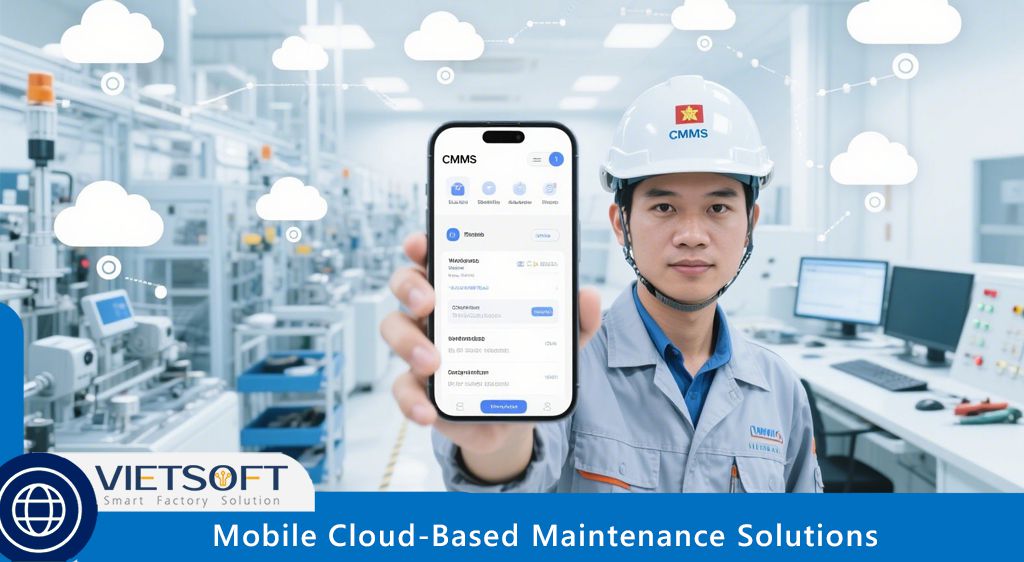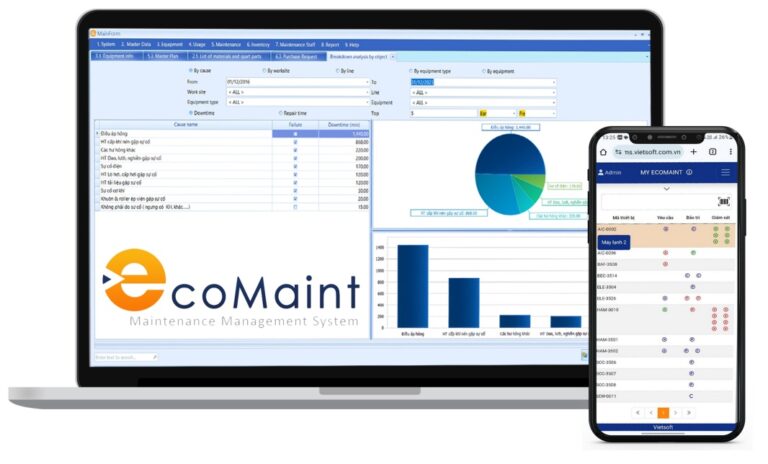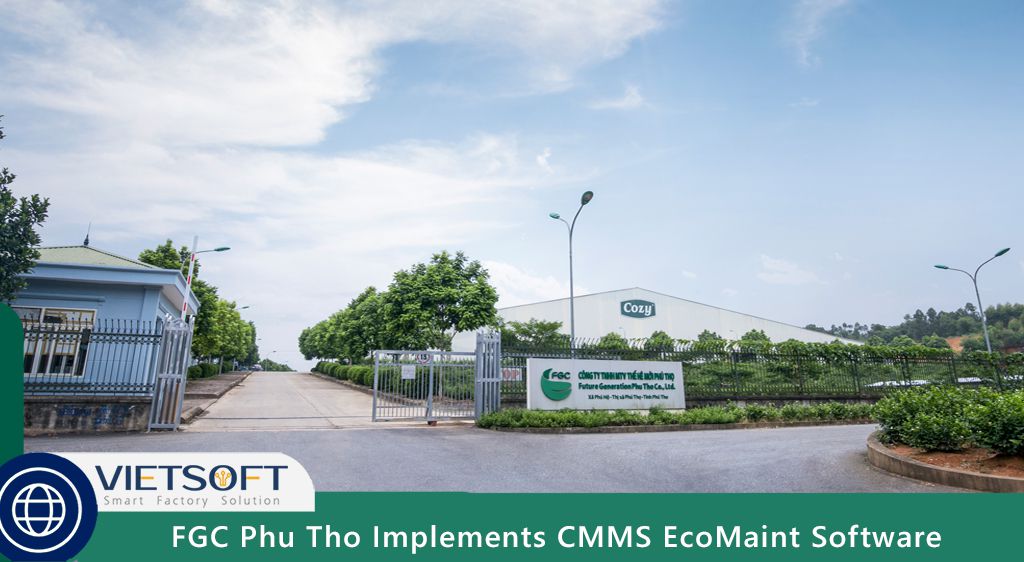
In the fast-evolving industrial landscape of 2025, Mobile Cloud-Based Maintenance Solutions are transforming how organizations manage maintenance operations. These innovative systems combine the power of cloud computing with mobile accessibility to streamline asset management, enhance operational efficiency, and reduce costly downtime. By leveraging real-time data, predictive analytics, and seamless integration with systems like CMMS (Computerized Maintenance Management Systems), these solutions empower maintenance teams to work smarter, not harder. This comprehensive guide explores the concept, benefits, and critical factors of Mobile Cloud-Based Maintenance Solutions, offering actionable insights for maintenance professionals and business leaders in Vietnam and beyond.
I. What Are Mobile Cloud-Based Maintenance Solutions?
Mobile Cloud-Based Maintenance Solutions refer to software platforms that integrate cloud technology and mobile applications to manage maintenance tasks, track assets, and optimize operational workflows. Hosted on cloud servers, these solutions provide centralized data storage, real-time updates, and mobile access, enabling technicians to perform tasks efficiently from anywhere. Unlike traditional paper-based or on-premise systems, these solutions offer scalability, flexibility, and advanced features like predictive maintenance and real-time analytics.
For example: a technician in a manufacturing plant can use a mobile device to access work orders, review asset histories, and report issues instantly, all while synchronized with a central cloud database. This seamless connectivity ensures that maintenance operations are data-driven, compliant with industry standards, and aligned with organizational goals.
II. Key Components of Mobile Cloud-Based Maintenance Solutions
· Cloud Infrastructure: Stores and processes maintenance data securely, ensuring accessibility and scalability.
· Mobile Applications: Provide technicians with real-time access to work orders, asset data, and communication tools.
· Predictive Analytics: Uses data trends to anticipate equipment failures and schedule proactive maintenance.
· Integration Capabilities: Connects with existing systems like ERP or IoT for a unified workflow.
· Real-Time Monitoring: Tracks asset performance and maintenance activities continuously.
By combining these components, Mobile Cloud-Based Maintenance Solutions enable organizations to transition from reactive to preventive maintenance, reducing downtime and improving productivity.
III. Why Mobile Cloud-Based Maintenance Solutions Matter in 2025
The industrial sector in Vietnam is undergoing a digital transformation, driven by the need for efficiency and competitiveness. Mobile Cloud-Based Maintenance Solutions are at the forefront of this shift, addressing key challenges in traditional maintenance practices, such as manual record-keeping, delayed responses, and lack of real-time insights. Here’s why these solutions are critical:
- Real-Time Data Access: Technicians can access critical information on the go, enabling faster decision-making and problem resolution.
- Cost Efficiency: Automation and predictive maintenance reduce labor costs and prevent expensive equipment failures.
- Scalability: Cloud-based systems can scale with business growth without requiring significant hardware investments.
- Regulatory Compliance: Centralized data storage simplifies audits and ensures adherence to industry standards like ISO 55000.
- Enhanced Collaboration: Mobile access fosters seamless communication between field teams and central offices.
For instance, in a Vietnamese manufacturing plant, a cloud-based CMMS like EcoMaint, developed by Vietsoft, allows technicians to receive instant alerts about equipment issues, access maintenance histories, and update work orders from their smartphones, significantly reducing response times.
IV. Benefits of Mobile Cloud-Based Maintenance Solutions
The adoption of Mobile Cloud-Based Maintenance Solutions offers transformative benefits for maintenance teams, operational managers, and organizations as a whole. Below are the key advantages, explained in detail:
1. Streamlined Work Order Management
Cloud-based systems automate the creation, assignment, and tracking of work orders. Technicians can view schedules, update task statuses, and upload photos or notes directly from their mobile devices. This eliminates paperwork and reduces errors, ensuring that tasks are completed efficiently and within regulatory compliance.
Example: A technician receives a work order to inspect a conveyor belt. Using a mobile app, they access the belt’s maintenance history, identify recurring issues, and complete the task, updating the system in real time.
2. Real-Time Asset Monitoring and Predictive Maintenance
By integrating IoT sensors and predictive analytics, Mobile Cloud-Based Maintenance Solutions enable continuous monitoring of equipment health. Data trends, such as vibration or temperature anomalies, trigger alerts for potential failures, allowing teams to schedule maintenance before issues escalate.
Example Calculation: Suppose a pump’s vibration level exceeds 5 mm/s, indicating a potential bearing failure. The system calculates the mean time to failure (MTTF) using historical data:
- MTTF = Total operating hours / Number of failures
- If the pump has operated for 10,000 hours with 2 failures, MTTF = 10,000 / 2 = 5,000 hours. This insight helps schedule maintenance at 4,500 hours to prevent downtime.
3. Enhanced Field Team Productivity
Mobile access empowers technicians to work independently, accessing critical information like manuals, schematics, and inventory levels from their devices. Offline functionality ensures continuity in areas with poor connectivity, while GPS tagging improves task allocation based on technician proximity.
Example: A field technician in a remote factory can access a digital checklist for a machine inspection, complete it offline, and sync the data once connectivity is restored, ensuring no delays.
4. Cost Reductions Through Automation
Automation of repetitive tasks, such as work order generation and inventory tracking, reduces manual labor and errors. Predictive maintenance minimizes emergency repairs, which can cost 3–5 times more than planned maintenance, according to industry studies.
Cost-Saving Example: Emergency repairs for a failed motor might cost $10,000, including downtime losses. Preventive maintenance, costing $2,000, saves $8,000 per incident.
5. Improved Regulatory Compliance and Audit Readiness
Centralized cloud storage ensures that maintenance records are secure, organized, and easily accessible for audits. This is critical for industries like manufacturing and pharmaceuticals, where compliance with standards like GMP (Good Manufacturing Practices) is mandatory.
Example: During an audit, a company can instantly provide a complete maintenance history for a critical asset, demonstrating compliance with safety regulations.
6. Global Accessibility and Collaboration
Cloud-based systems enable teams across multiple locations to access the same data, fostering collaboration. Managers can monitor performance metrics, while technicians share real-time updates, creating a cohesive workflow.
Example: A maintenance manager in Hanoi can assign tasks to a technician in Ho Chi Minh City, with both accessing the same cloud-based platform for updates.
V. Critical Factors for Choosing Mobile Cloud-Based Maintenance Solutions
Selecting the right Mobile Cloud-Based Maintenance Solution is crucial for maximizing benefits. Based on industry best practices and the unique needs of Vietnam’s industrial sector, here are seven key factors to consider:
1. Small Screen Optimization
Mobile apps must be designed for small screens, prioritizing relevant data and simple navigation. A cluttered interface can frustrate users and reduce adoption rates.
Best Practice: Choose apps with clean layouts, minimalistic designs, and contextual help features to enhance usability.
2. Real-Time Data Access
Real-time data is essential for informed decision-making. Solutions should provide instant updates on asset status, work orders, and inventory levels.
Example: A technician receives an alert about a machine fault, accesses its performance data, and assigns the task to the nearest available colleague using GPS.
3. Offline Data Synchronization
In areas with unreliable internet, offline functionality is critical. The app should store data locally and sync automatically when connectivity is restored.
Best Practice: Test the app’s offline capabilities to ensure seamless operation in remote or low-connectivity environments.
4. App Performance and Responsiveness
A slow or buggy app can hinder productivity. Regular updates and user feedback are essential to maintain performance.
Example: An app that loads work orders in under 2 seconds improves technician efficiency compared to one with frequent freezes.
5. Intuitive User Interface
An intuitive interface reduces training time and boosts adoption. Features like drag-and-drop functionality and customizable dashboards enhance user experience.
Best Practice: Opt for solutions with user-friendly designs and multilingual support, especially for Vietnam’s diverse workforce.
6. Customization Flexibility
Every organization has unique needs. The solution should allow customization of fields, workflows, and reports to align with specific processes.
Example: A factory can customize the app to include fields for specific compliance requirements, such as energy consumption data.
7. Native vs. Hybrid Applications
Native apps offer better performance and user experience compared to hybrid apps, especially for complex maintenance tasks.
Best Practice: Invest in native apps for critical operations, ensuring compatibility with iOS and Android devices.
VI. Trends Shaping Mobile Cloud-Based Maintenance Solutions in 2025
The landscape of Mobile Cloud-Based Maintenance Solutions is evolving rapidly, driven by technological advancements. Here are key trends to watch:
1. Edge Computing
Edge computing processes data closer to the source, reducing latency and improving real-time decision-making. For example, a sensor on a machine can analyze data locally and send alerts to the cloud, minimizing delays.
2. AI and Automation
AI-driven maintenance uses machine learning to predict failures and automate routine tasks. For instance, AI can analyze historical data to prioritize critical repairs, reducing manual intervention.
3. Hybrid and Multi-Cloud Strategies
Organizations are adopting hybrid cloud models, combining public and private clouds for flexibility and security. This approach ensures data redundancy and compliance with local regulations.
4. Microservices and Containerization
Using tools like Docker and Kubernetes, maintenance apps are becoming more modular, allowing independent updates and scalability.
5. Enhanced Security and Compliance
With stricter regulations like GDPR, cloud providers are prioritizing security features like encryption and automated compliance checks.
VII. Challenges of Implementing Mobile Cloud-Based Maintenance Solutions
While the benefits are significant, organizations may face challenges when adopting these solutions:
· Data Privacy Concerns: Sensitive maintenance data stored in the cloud must be protected against breaches. Solutions should include robust encryption and compliance with local regulations.
· Dependency on Cloud Providers: Vendor lock-in can limit flexibility. Choose providers with transparent pricing and data migration options.
· Performance Issues: Latency in cloud-based apps can affect user experience. Opt for solutions with edge computing capabilities to minimize delays.
· Cost Management: Unmonitored resource usage can lead to cost overruns. Regularly review usage analytics to optimize expenses.
· Training and Adoption: Transitioning to mobile solutions requires training. Select user-friendly apps to minimize resistance.
VIII. How Vietsoft’s EcoMaint Leverages Mobile Cloud-Based Maintenance Solutions
For organizations in Vietnam seeking a robust Mobile Cloud-Based Maintenance Solution, Vietsoft’s EcoMaint CMMS stands out as a leading choice. Designed specifically for the Vietnamese market, EcoMaint integrates cloud technology and mobile accessibility to streamline maintenance operations. Key features include:
- Real-Time Work Order Management: Technicians can access and update work orders on the go, ensuring rapid response times.
- Predictive Maintenance Analytics: EcoMaint uses data trends to predict equipment failures, reducing downtime and costs.
- Seamless Integration: The platform connects with ERP and IoT systems, creating a unified workflow.
- User-Friendly Mobile App: Optimized for small screens, EcoMaint’s app supports offline functionality and multilingual interfaces, catering to Vietnam’s diverse workforce.
By implementing EcoMaint, businesses can achieve operational excellence, comply with industry standards, and drive profitability. Curious to see how EcoMaint can transform your maintenance operations? Learn more about CMMS EcoMaint here.
Contact us for consultation via hotline: 0986778578 or email: sales@vietsoft.com.vn.
IX. Best Practices for Implementing Mobile Cloud-Based Maintenance Solutions
To maximize the value of these solutions, follow these best practices:
· Conduct a Needs Assessment: Identify your organization’s specific maintenance challenges and goals before selecting a solution.
· Prioritize User Training: Invest in training programs to ensure smooth adoption by technicians and managers.
· Start with a Pilot Program: Test the solution on a small scale to identify issues before full deployment.
· Monitor KPIs: Track metrics like downtime reduction, cost savings, and task completion rates to measure success.
· Regularly Update the System: Stay current with software updates to leverage new features and maintain performance.
X. Conclusion: The Future of Maintenance with Mobile Cloud-Based Solutions
Mobile Cloud-Based Maintenance Solutions are redefining industrial maintenance by combining cloud technology, mobile accessibility, and advanced analytics. These systems empower organizations to reduce downtime, optimize resources, and enhance compliance, all while fostering a culture of efficiency and collaboration. In Vietnam’s rapidly growing industrial sector, solutions like Vietsoft’s EcoMaint are paving the way for smarter maintenance practices.
By embracing these technologies, businesses can transition from reactive to preventive maintenance, ensuring long-term competitiveness and sustainability. Ready to take your maintenance operations to the next level? Discover how EcoMaint can revolutionize your workflows.




